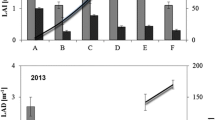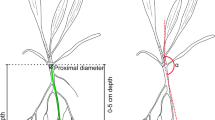Abstract
Rooting space is considered as a resource in plants, but comparative studies on the biomass allocation plasticity in response to rooting volume (RV) are rare. We compared responses in growth, biomass allocation and ontogenetic heteroblasty in nine hard pine species of contrasted ecology. Seedlings were cultivated in containers of 0.2, 0.5, 1.0, 2.8 and 7 L for two growing seasons (425 days). Reduction in RV caused a reduction in plant absolute and relative growth rate and biomass allocated to stems but it increased biomass allocated to roots. RV affected to a lesser extent and in a less consistent direction allocation to leaves. Species that grew faster (higher relative growth rate) had a steeper decrease in growth with the reduction in RV. Ontogenetic heteroblasty, evaluated as the proportion of secondary needles in the needle biomass, showed highly different plasticity patterns in response to RV. Decrease in RV caused negligible or no change either in the most ontogenetically delayed Mediterranean pines or in the most ontogenetically advanced pines, the mesic Pinus sylvestris and P. uncinata. By contrast, ontogenetically intermediate species showed steep reaction norms in response to reduction in RV. While P. pinaster and P. brutia showed marked rejuvenation, P. nigra accelerated the development of adult foliage.




Similar content being viewed by others
Abbreviations
- RV:
-
Rooting volume
- RR:
-
Root restriction
- TM:
-
Total plant biomass
- AGR:
-
Absolute height growth rate
- RGR:
-
Relative height growth rate
- RMF:
-
Root mass fraction
- SMF:
-
Stem mass fraction
- LMF:
-
Leaf mass fraction
- SNMF:
-
Secondary needles mass fraction
References
Aiken RM, Smucker AJM (1996) Root system regulation of whole plant growth. Annu Rev Phytopathol 34:325–346
Alpert P, Simms EL (2002) The relative advantages of plasticity and fixity in different environments: when is it good for a plant to adjust? Evol Ecol 16:285–297
Aphalo P, Rikala R (2003) Field performance of silver-birch planting-stock grown at different spacing and in containers of different volume. New Forests 25:93–108
Beeson RC (1993) Benefits of progressively increasing container size during nursery production depend on fertilizer regime and species. J Am Soc Hortic Sci 118:752–756
Cannell MGR, Thompson S, Lines R (1976) An analysis of inherent differences in shoot growth within some north temperate conifers. In: Cannell MGR, Last FT (eds) Tree physiology and yield improvement. Academic Press, London, pp 173–205
Cao KF, Ohkubo T (1998) Allometry, root/shoot ratio and root architecture in understory saplings of deciduous dicotyledonous trees in central Japan. Ecol Res 13:217–227
Carlson LW, Endean F (1976) The effect of rooting volume and container configuration on the early growth of white spruce seedlings. Can J For Res 6:221–224
Chambel MR, Climent J, Alía R (2007) Divergence among species and populations of Mediterranean pines in biomass allocation of seedlings grown under two watering regimes. Ann For Sci 64:87–97
Clemens J, Henriod RE, Bailey DG, Jameson P (1999) Vegetative phase change in Metrosideros: Shoot and root restriction. Plant Growth Regul 28:207–214
Climent J, Alonso J, Gil L (2008) Root restriction hindered early allometric differentiation between seedlings of two provenances in Canary Island pine. Silvae Genetica 57:187–193
Climent J, Costa e Silva F, Chambel MR, Pardos M, Almeida H (2009) Freezing injury in primary and secondary needles of Mediterranean pine species of contrasting ecological niches. Ann For Sci 66:407–415
Climent J, San-Martín R, Chambel MR, Mutke S (in press) Ontogenetic differentiation between Mediterranean and Eurasian pines (sect. Pinus) at the seedling stage. Trees-Structure and Function. doi: 10.1007/s00468-010-0496-8
Colombo SJ, Menzies MI, O’Reilly C (2001). Influence of nursery cultural practices on cold hardiness of coniferous forest tree seedlings. In: Bigras FJ and Colombo SJ (eds) Conifer cold hardiness. Kluwer Academic Publishers, Dordrecht, Boston, pp 223–252
Cuesta B, Villar-Salvador P, Puértolas J, Jacobs D, Rey Benayas JM (2010) Why do large, nitrogen rich seedlings better resist stressful transplanting conditions? A physiological analysis in two functionally contrasting Mediterranean forest species. For Ecol Manag 260:71–78
Dominguez-Lerena V, Herrero N, Carrasco I, Ocaña L, Peñuelas JL, Mexal JG (2006) Container characteristics influence Pinus pinea seedling development in the nursery and field. For Ecol Manag 221:63–71
Endean F, Carlson LW (1975) The effect of rooting volume on the early growth of lodgepole pine seedlings. Can J For Res 5:55–60
Ferree DC, Myers SC, Schupp JR (1992) Root pruning and root restriction of fruit trees-current review. Acta Horticulturae (ISHS) 322:153–166
Forster MA, Bonser SP (2009) Heteroblastic development and the optimal partitioning of traits among contrasting environments in Acacia implexa. Ann Bot 103:95–105
Grotkopp E, Rejmanek M, Rost TL (2002) Toward a causal explanation of plant invasiveness: seedling growth and life-history strategies of 29 pine (Pinus) species. Am Nat 159:396–419
Hsu YM, Tseng MJ, Lin CH (1996) Container volume affects growth and development of wax-apple. Hortscience 31:1139–1142
Hunt R, Causton DR, Shipley B, Askew AP (2002) A modern tool for classical plant growth analysis. Ann Bot 90:485–488
Lamhamedi MS, Bernier PY, Hébert C, Jobidon R (1998) Physiological and growth responses of three sizes of containerized Picea mariana seedlings outplanted with and without vegetation control. For Ecol Manag 110:13–23
Landis T (1990) Containers: types and functions. In: Landis TD, Tinus RW, McDonald SE, Barnett JP (eds) The container tree nursery manual. USDA Forest Service, Washington, 88 p
Lascoux DM, Kremer A, Dormling I (1993) Growth and phenology of 1-year-old maritime pine (Pinus pinaster) seedlings under continuous light - Implications for early selection. Can J For Res 23:1325–1336
Ledig FT, Perry TO (1966) Physiological genetics of the shoot-root ratio. Proc Soc Am Foresters 1965:30–43
Leishman MR, Wright IJ, Moles AT, Westoby M (2000) The evolutionary ecology of seed size. Seed: ecology of regeneration in plant communities. Univ. Southampton, UK 416p:31–59
Lester D (1968) Developmental patterns of axillary meristematic activity in seedlings of Pinus. Botanical Gazette 129:206–210
Livonen S, Rikala R, Vapaavuori E (2001) Seasonal root growth of Scots pine seedlings in relation to shoot phenology, carbohydrate status, and nutrient supply. Can J For Res 31:1569–1578
Lloret F, Casanovas C, Penuelas J (1999) Seedling survival of Mediterranean shrubland species in relation to root:shoot ratio, seed size and water and nitrogen use. Funct Ecol 13:210–216
Lortie CJ, Aarssen LW (1996) The specialization hypothesis for phenotypic plasticity in plants. Int J Plant Sci 157:484–487
Luis V, Puértolas J, Climent J, Peters J, González-Rodríguez A, Morales D, Jiménez MS (2009) Nursery fertilization enhances survival and physiological status in Pinus canariensis seedlings planted in a semiarid environment. Eur J For Res 128
McConnaughay KDM, Bazzaz FA (1991) Is physical space a soil resource? Ecology 72:94–103
McConnaughay KDM, Coleman JS (1999) Biomass allocation in plants: ontogeny or optimality? A test along three resource gradients. Ecology 80:2581–2593
Milliken GA, Johnson DA (1992) Analysis of messy data. Volume III: analysis of covariance. Chapman and Hill, London
NeSmith DS, Duval JR (1998) The effect of container size. HortTechnology 8:495–498
NeSmith DS, Bridges DC, Barbour JC (1992) Bell pepper responses to root restriction. J Plant Nut 15:2763–2776
Oliet JA, Planelles R, Artero F, Valverde R, Jacobs DF, Segura ML (2009) Field performance of Pinus halepensis planted in Mediterranean arid conditions: relative influence of seedling morphology and mineral nutrition. New For 37:313–331
Pardos M, Calama R, Climent J (2009) Difference in cuticular transpiration and sclerophylly in juvenile and adult pine needles relates to the species-specific rates of development. Trees Struct Funct 23:501–508
Poorter H, Nagel O (2000) The role of biomass allocation in the growth response of plants to different levels of light, CO2, nutrients and water: a quantitative review. Aus J Plant Physiol 27:595–607
Riedacker A (1976) Rythmes de croissance et de régénération des racines des végétaux ligneux. Annales des Sciences Forestières 33:109–138
Ritchie GA (1984) Assessing seedling quality. In: Duryea ML, Landis TD (eds) Forest nursery manual: production of bareroot seedlings. Martinus Nijhoff/Dr. W. Junk, The Hague/Boston/Lancaster, pp 243–259
Sanchez-Gomez D, Valladares F, Zavala MA (2006) Functional traits and plasticity in response to light in seedlings of four Iberian forest tree species. Tree Physiol 26:1425–1433
Schlichting CD, Pigliucci M (1998) Phenotypic evolution–a reaction norm prespective. Sinauer Associates, Sunderland, MA
Serre F (1976) Les rapports de la croissance et du climat chez le pin d’alep (Pinus halepensis Mill.). Acta Oecologica. Oecologia Plantarum 11:143–171
Smit-Spinks B, Swanson BT, Markhart AH III (1985) The effect of photoperiod and thermoperiod on cold acclimation and growth of Pinus sylvestris. Can J For Res 15:453–460
South DB, Harris SW, Barnett JP, Hainds MJ, Gjerstad DH (2005) Effect of container type and seedling size on survival and early height growth of Pinus palustris seedlings in Alabama, USA. For Ecol Manag 204:385–398
Strauss SH, Ledig FT (1985) Seedling architecture and life-history evolution in pines. Am Nat 125:702–715
Thompson BE (1985) Seedling morphological evaluation. What you can tell by looking. In: Duryea ML (ed) Evaluating seedling quality: principles, procedures, and predictive abilities of major tests. Oregon State University, Corvallis (Oregon), pp 59–71
Valladares F, Dobarro I, Sanchez-Gomez D, Pearcy RW (2005) Photoinhibition and drought in Mediterranean woody saplings: scaling effects and interactions in sun and shade phenotypes. J Exp Bot 56:483–494
Valladares F, Gianoli E, Gómez JM (2007) Ecological limits to plant phenotypic plasticity. New Phytol 176:749–763
Villar-Salvador P, Planelles R, Enriquez E, Peñuelas-Rubira J (2004) Nursery cultivation regimes, plant functional attributes, and field performance relationships in the Mediterranean oak Quercus ilex L. For Ecol Manag 196:257–266
Villar-Salvador P, Valladares F, Domínguez-Lerena S, Ruiz-Díez B, Fernández-Pascual M, Delgado A, Peñuelas Rubira JL (2008) Functional traits related to seedling transplanting performance in the Mediterranean leguminous shrub Retama sphaerocarpa: insights from a provenance, fertilization and rhizobial inoculation study. Environ Exp Bot 64:145–154
Williams DR, Potts BM, Smethurst PJ (2004) Phosphorus fertiliser can induce earlier vegetative phase change in Eucalyptus nitens. Aust J Bot 52:281–284
Wilson B, Jacobs D (2006) Quality assessment of temperate zone deciduous hardwood seedlings. New For 31:417–433
Acknowledgments
This study was supported by projects AT05-002 and AT07-002 of INIA, CGL2007-60533/BOS, AGL2006-12609-C02-01/FOR of the Spanish Ministry of Science and Education, and S-0505/AMB/0355-REMEDINAL of Madrid Government. Nursery work was carried by TRAGSA (Maceda, Spain). Thanks to N. Godoy, F. Salgado and I. Blanco for nursery and laboratory work and to G. Ruiz and L. Rodríguez for supervising the whole experiment. The English version was kindly revised by Marcas Ó Murchú, Derry, Ireland.
Author information
Authors and Affiliations
Corresponding author
Additional information
Communicated by R. Matyssek.
Rights and permissions
About this article
Cite this article
Climent, J., Chambel, M.R., Pardos, M. et al. Biomass allocation and foliage heteroblasty in hard pine species respond differentially to reduction in rooting volume. Eur J Forest Res 130, 841–850 (2011). https://doi.org/10.1007/s10342-010-0476-y
Received:
Revised:
Accepted:
Published:
Issue Date:
DOI: https://doi.org/10.1007/s10342-010-0476-y




